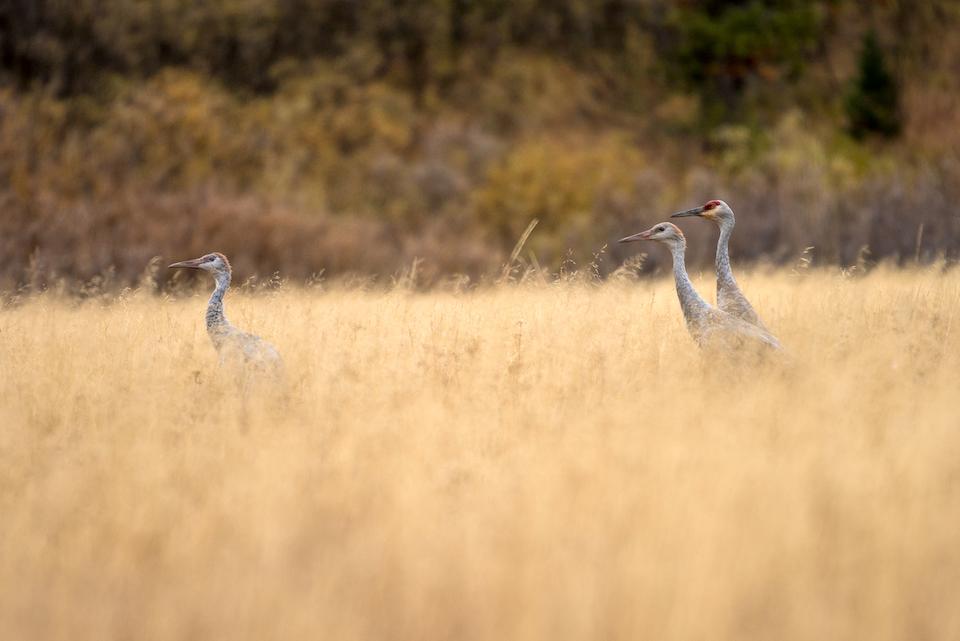
Sandhill cranes are gaining more native landscape in Grand Teton National Park/NPS
Editor's note: The following article was provided by the Grand Teton National Park Foundation.
Jackson Hole’s early homesteaders settled in the area now known as Mormon Row in Grand Teton National Park, partly because of the unusually deep topsoil there. Beginning in the late 1800s, they converted large swaths of the sagebrush grasslands to pasture and hay field grasses for agricultural use. These irrigated crops eventually covered more than 4,000 acres and became known as the Kelly Hayfields.
Their preferred crop was smooth brome, a non-native perennial grass well suited to cool, short growing seasons. It provided livestock with good nutrition during its growing stage and could be baled for use during the rest of the year. Historic photos of the area reveal a rich, pastoral landscape in an unusually stunning setting, with the Teton Range as its backdrop.
When the 1950 expansion of Grand Teton enveloped Mormon Row, and as the National Park Service began acquiring its lands in the 1960s, active cultivation gradually diminished. The converted pasture species persisted, however, and compared to native vegetative communities, the unirrigated, nonnative vegetation had little value to bison, elk, sage grouse, and other wildlife, particularly outside of the primary growing season.
Park managers have had long-standing interest in returning the formerly cultivated fields to native sagebrush-grasslands, but the task was daunting, and they lacked necessary resources. But in the 1990s, as ecological stewardship programs grew, visionary park biologists began deliberate assessments of what could be done there and how to go about it.

An archival photo of the Kelly Hayfields in Grand Teton National Park/National Park Service, Historic Fire Records, GRTE-00552, Photographer LM Moe
They began with research out of necessity, because the knowledge needed to develop an effective strategy did not exist. Through a multi-year, systematic series of small scale, controlled experiments in the pastures, patterns of successful approaches began to emerge, and a course of action was charted. The park formalized its ambitious plan in 2007, and the current effort to restore 4,500 acres of the Kelly Hayfields began.
To date, nearly 1,500 acres are in various stages of restoration, with areas furthest along containing well-established native plant assemblages. Even to the untrained eye, comparing pastures at both ends of the restoration spectrum during the peak of growing season leaves one awestruck. The restored fields are alive with the colors of native flowering plants, and animal tracks and scat attest to the invigorated benefits to park wildlife. Sage-grouse research data show a dramatic shift from avoidance of the old pastures to heavy use of the restored landscapes, while field observations document heavy use by elk, bison, and pronghorn.
The Kelly Hayfields restoration program is a primary feature of a larger conservation and re-wilding effort for the greater Hayfields area. Its location between the Snake River and Gros Ventre mountains, proximity to Blacktail Butte, and habitat importance to a wide variety of species, offer a remarkable opportunity to restore this area adjacent to expansive sagebrush-steppe landscapes in near pristine condition, including those protected in Antelope Flats.
The Grand Teton National Park Foundation has provided more than $120,000 to this important project through generous support from private donors, Teton Conservation District, and the National Fish and Wildlife Foundation. Concurrent restorative activities—also supported by the Foundation—for Kelly Warm Springs and Ditch Creek, and concerted efforts to stabilize and enhance the Mormon Row Historic District, add considerably to its stature and overall importance, enhancing the ecological function and value of this popular and accessible area to all park visitors.
Restoration Process
- Collection of native plant seeds
- Propagation of native plants and seed off-site
- Removal of existing nonnative vegetation
- Replanting with native seeds and plants
- Ongoing control of invasive plants
- Use of temporary fencing when necessary until restored areas can withstand grazing pressure
- Monitoring and reapplication of previous steps when necessary
- Harvesting of native seed from established restoration sites for use on future sites

 Support Essential Coverage of Essential Places
Support Essential Coverage of Essential Places







Comments
Great piece! Great news in a time of great need.
Imho, would've benefitted from inclusion of graphics, especially maps showing where in the park these plots exist, and perhaps a larger scale map showing the acreage in relation to the migration corridors envisioned in continental scale rewilding discussions.
Thanks for the article!
Yes indeed maps showing the area would be great!